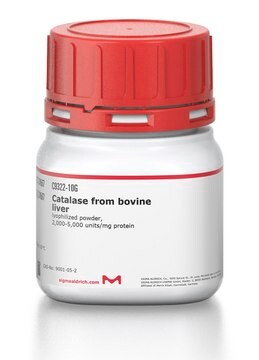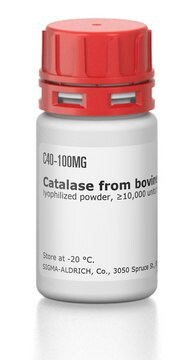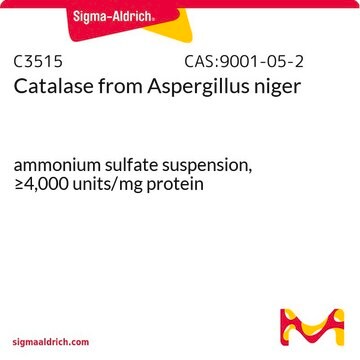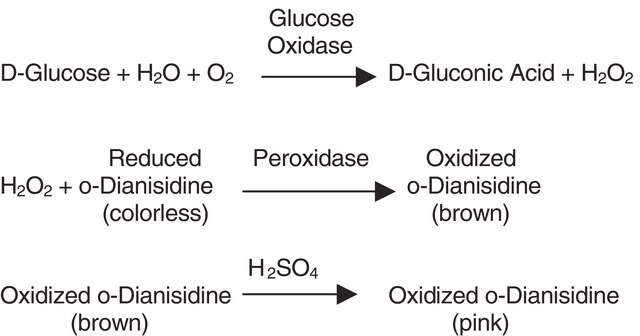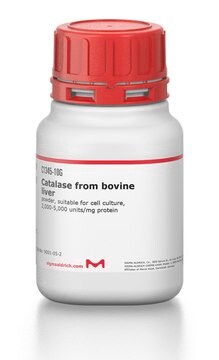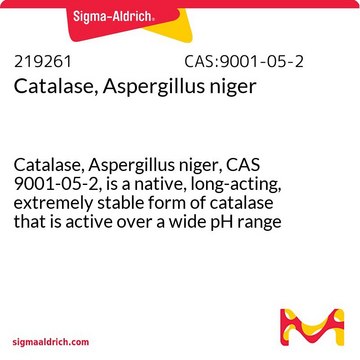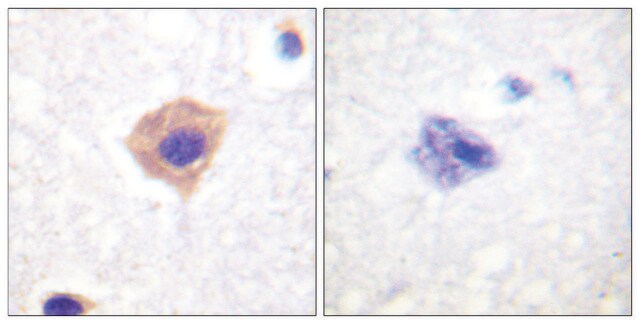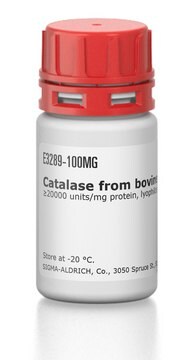Alle Fotos(1)
Wichtige Dokumente
02071
Katalase aus Corynebacterium glutamicum
solution, deep brown, ≥500000 U/mL
Anmeldenzur Ansicht organisationsspezifischer und vertraglich vereinbarter Preise
Alle Fotos(1)
About This Item
CAS-Nummer:
MDL-Nummer:
UNSPSC-Code:
12352204
NACRES:
NA.54
Empfohlene Produkte
Biologische Quelle
bacterial (Corynebacterium glutamicum)
Qualitätsniveau
Form
solution
Konzentration
≥500000 U/mL
Farbe
deep brown
Versandbedingung
wet ice
Lagertemp.
2-8°C
SMILES String
O(CC)C(=O)c1ccc(cc1)O
InChI
1S/C9H10O3/c1-2-12-9(11)7-3-5-8(10)6-4-7/h3-6,10H,2H2,1H3
InChIKey
NUVBSKCKDOMJSU-UHFFFAOYSA-N
Allgemeine Beschreibung
Catalase is ubiquitously found in animals, plants, fungi, and humans. It is made up of looped polypeptide chains that are arranged as tetramers or dimers and a core, that contains iron or manganese ions. Catalase can be differentiated into two types such as heme-containing (type I), which possesses an iron-porphyrin cofactor and a non-heme-containing (type II), which possesses a dinuclear manganese active site.
Anwendung
Catalase from Corynebacterium glutamicum has been used to identify and characterize purified bacterial peptide (PPBP) produced from Bacillus thuringiensis. It has also been used to study its inhibition by nitric oxide.
Biochem./physiol. Wirkung
Catalase is an antioxidant enzyme that plays a role in alleviating oxidative stress by the removal of hydrogen peroxide to produce oxygen and water. Lower levels of catalase lead to several age-related disorders including hypertension, anemia, vitiligo, Parkinson′s disease, Alzheimer′s disease, schizophrenia, bipolar disorders, diabetes mellitus, and cancer.
Einheitendefinition
1 U entspricht der Enzymmenge, die 1 μmol Wasserstoffperoxid pro Minute bei pH 7.0 und 25°C abbaut
Physikalische Form
enthält ~30% Glycerin, 10% Ethanol
Sonstige Hinweise
The purity of this product is not determined. It is tested and sold by activity rather than mass.
Signalwort
Warning
H-Sätze
Gefahreneinstufungen
Flam. Liq. 3
Lagerklassenschlüssel
3 - Flammable liquids
WGK
WGK 1
Flammpunkt (°F)
105.8 °F - closed cup
Flammpunkt (°C)
41 °C - closed cup
Persönliche Schutzausrüstung
Eyeshields, Faceshields, Gloves, type ABEK (EN14387) respirator filter
Hier finden Sie alle aktuellen Versionen:
Besitzen Sie dieses Produkt bereits?
In der Dokumentenbibliothek finden Sie die Dokumentation zu den Produkten, die Sie kürzlich erworben haben.
Kunden haben sich ebenfalls angesehen
Nitin Kumar et al.
Science advances, 4(10), eaat7779-eaat7779 (2018-10-20)
Active materials are capable of converting free energy into directional motion, giving rise to notable dynamical phenomena. Developing a general understanding of their structure in relation to the underlying nonequilibrium physics would provide a route toward control of their dynamic
Angela Sacchi et al.
Environmental pollution (Barking, Essex : 1987), 177, 82-89 (2013-03-12)
Coastal lagoons are constantly subjected to releases of chemical pollutants, and so organisms may be exposed to such toxicants. This study investigated through a multivariate approach the physiological status of bivalve Ruditapes philippinarum, farmed in Sacca di Goro lagoon. Biomarkers
L V Barabash
Klinicheskaia laboratornaia diagnostika, (12)(12), 14-17 (2013-03-14)
The technique of cosinor-analysis was applied to study the oncological dynamics of hormonal and lipid status, activity of peroxide oxidation of lipids in 580 healthy males and females residing in the Western Siberia. The clear circannual rhythm of gluco-corticoid function
Zh P Kopteva et al.
Mikrobiolohichnyi zhurnal (Kiev, Ukraine : 1993), 75(1), 41-47 (2013-03-23)
Lipolytic and catalase activity of Pseudomonas pseudoalcaligenes 109, Rhodococcus erythropolis 102, Bacillus subtilis 138 and their association with different growth models: biofilm and plankton ones. It is shown that under biofilm conditions the fermentative activity of bacteria under study was
Milka O Montes et al.
International journal of phytoremediation, 15(2), 168-187 (2013-03-16)
Hexavalent chromium is a contaminant highly mobile in the environment that is toxic for plants at low concentrations. In this work, the physiological response of Convolvulus arvensis and Medicago truncatula plants to Cr(VI) treatments was compared. C. arvensis is a
Unser Team von Wissenschaftlern verfügt über Erfahrung in allen Forschungsbereichen einschließlich Life Science, Materialwissenschaften, chemischer Synthese, Chromatographie, Analytik und vielen mehr..
Setzen Sie sich mit dem technischen Dienst in Verbindung.